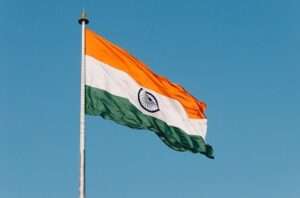“The Pink City”, Jaipur, is the capital of the state, of Rajasthan. Jaipur is called the “Pink City” because it was painted in pink in the year 1876 to welcome the Queen of England, Victoria and her husband, the Prince of Wales, Prince Albert. This city is famous for its royal elegance and grandeur. Jaipur was home to the Rajput rulers, their rich lifestyle, food, culture, heritage, courage and warmth can still be seen and experienced today.
The city boasts its majestic monuments, colourful bazaars, busy streets, family-run restaurants, palaces, hotels, temples and historical places. Jaipur has held onto its old-world charm. It is a UNESCO World Heritage City and has many UNESCO World Heritage Sites. See the tentative list of Unesco Sites in India. While entering Jaipur, you can experience the beauty of the Aravalli hills.
The city of Jaipur was founded in 1727 by the Rajput ruler Maharaja Jai Singh ||. The city is named after him. Jaipur is the earliest planned city in modern India. The city was modelled by Vidyadhar Bhattacharya. Jaipur is famous not only among Indian tourists but also among foreign tourists. Every year more than 20 lakh tourists visit this place.
Want to experience the Rajputana lifestyle and valour? Make sure to add Jaipur to your travel list. So, here we present a one-stop guide for the 21 best places to visit in Jaipur.
Top 21 places to visit in Jaipur
1. Hawa Mahal
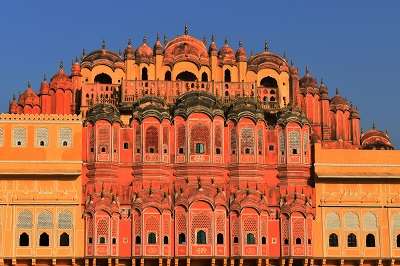
It is also known as the “Palace of Winds” or the “Palace of Breeze”. Maharaja Sawai Pratap Singh built this palace in 1799. It is a honeycomb structure with 953 small windows called Jharokhas. This was originally built for the royal ladies to observe everyday life and festivals celebrated in the street. The architecture is such that the palace remains cool during summer. This red and pink sandstone structure is a treat to the eyes.
- Timings: 09:00 a.m to 05:00 p.m on all days of the week.
- Entry fee: ₹50 for Indians and ₹200 for foreign tourists.
2. Amber fort
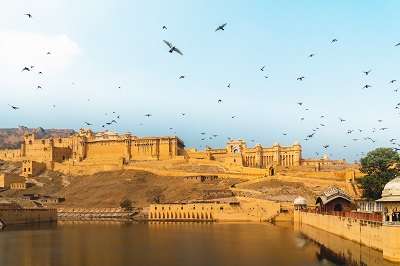
The historic Amber fort was constructed by Raja Man Singh and completed by Sawai Jai Singh. The construction was started in 1592 and completed in the 8th century. The fort derives its name from Ambikeshwara (Lord Shiva) or Amba (Goddess Durga). The fort is situated on a hilltop. The architecture is a fine mixture of the Rajputana and Hindu styles. It is also known as Amer fort. It has the Diwan-e-Aam, Diwan-e-Khas, Sheesh Mahal, Jai Mandir and Sukh Niwas. The entrance to the palace is known as the Ganesh Gate. There is a temple dedicated to Shila Devi at the entrance. It was declared a UNESCO World Heritage Site in 2003.
- Timings: 08:00 a.m. – 5:30 p.m. and 06:30 p.m. – 09:15 p.m. on all days of the week.
- Entry fee: ₹550 for Foreign tourists. ₹100 for foreign students. ₹50 for Indian tourists. ₹10 for Indian students.
3. Nahargarh fort
Nahargarh means the “abode of tigers”. The fort is surrounded by dense forest which is a part of Nahargarh Biological Park. It was built by Sawai Madho Singh in 1734. It was connected with Jaigarh and Amer fort and formed a protection boundary surrounding the hills. According to local folklore, the spirit of Nahar Singh Bhomia haunted this place and created obstructions during the construction. Inside the building, there is a temple which was built in his memory to pacify his soul.
- Timings: 10:00 a.m. to 05:30 p.m. on all days of the week.
- Entry fee: ₹50 for Indian tourists and ₹5 for Indian students. ₹200 for foreign tourists and ₹25for foreign students.
4. The City Palace
It stands in the middle of the city. Maharaja Sawai Jai Singh II built the City Palace in 1727. The architecture of the City Palace is a fusion of the Rajputana, Shilpashastra, Mughal and European styles. It has the Govind Dev Ji temple, Chandra Mahal, Diwan-e-aam, Diwan-E-Khas, Pritam Niwas Chowk, Mubarak Mahal, Clock Tower, Maharani Mahal and Maharaja Sawai Man Singh II Museum. The City Palace is also the home of the Royal family of Jaipur. It was used for ceremonial, religious, administrative and cultural events. The complex includes various courtyards, galleries, restaurants, and offices of the Museum Trust.
- Timings: 09:30 a.m. to 05:00 p.m. and 07:00 p.m. to 10:00 p.m. on all days of the week.
Entry fee:
| Museum | Composite | Museum at night | Royal Grandeur | Royal Splendor | |
| Adult | ₹200 | ₹300 | ₹500 | ₹1500 | ₹3000 |
| Children (5-12 years) | ₹100 | ₹200 | ₹250 | ₹1000 | ₹1500 |
| Senior citizen/Defence personnel | ₹100 | ₹200 | ₹380 | _ | _ |
| Composite | Museum at night | Royal Grandeur | Royal Splendor | |
| Adult | ₹700 | ₹1000 | ₹2000 | ₹3500 |
| Children | ₹400 | ₹500 | ₹1500 | ₹2000 |
| Disabled | ₹430 | ₹780 | _ | _ |
5. Jaigarh fort
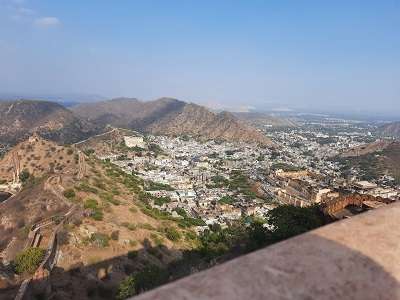
It is situated on a hilltop of the Aravalli range along with the Amer Fort and the Nahargarh fort. Built by Sawai Jai Singh in 1726, Jaigarh Fort was made to protect the Amer Fort. It is also known as the “Fort of Victory”. Nahargarh fort, Jaigarh Fort and Amer Fort are connected by passages and is considered as one complex.
- Timings: 09:00 a.m. to 04:45 p.m. on all days of the week.
- Entry fee: ₹35 for Indians and ₹85 for Foreign Tourists.
- Camera fee: ₹50 for a Still Camera and ₹200 for Video Camera.
6. Jal Mahal
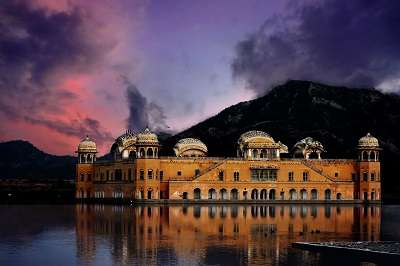
Jal Mahal also known as the Water Palace is situated on the Man Sagar Lake. It was constructed in 1699. The architecture of the fort is a mixture of Rajput and Mughal styles. You have to take a boat to reach the palace. Entry is not allowed for visitors inside the palace but you can take a boat around the palace and also click some amazing pictures outside.
- Timings: 06:00 a.m to 06:00 p.m on all days of the week.
- Entry fee: None. Entry is not allowed to visitors as it has been converted into a restaurant.
7. Jantar Mantar
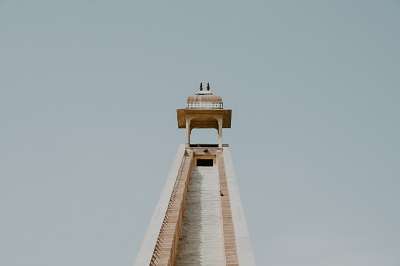
Jantar Mantar is an observatory built by Maharaja Sawai Jai Singh || in 1734. It is a UNESCO World Heritage Site. It is a collection of many astronomical instruments used in earlier times. Its name is derived from Sanskrit. Jantar or “Yantra” means an instrument/machine. Mantar or “Mantrana” means to “consult/calculate”. Jantar Mantar literally means an “instrument for calculating”.
- Timings: 09:00 a.m to 04:30 p.m on all days of the week.
- Entry fee: ₹50 for Indian tourists and ₹15 for Indian students. ₹200 for foreign tourists and ₹100 for foreign students.
8. Panna Meena ka Kund
This is an offbeat location near Amer fort. It is a historical stepwell built in the 16th century. This 8-floored stepwell is 200 feet deep and has 1800 steps. It is very near to the Anokhi Museum. It was used to conserve rainwater when Amer was the capital of Rajasthan.
- Timings: 07:00 a.m to 06:00 p.m on all days of the week.
- Entry fee: Free
9. Patrika Gate
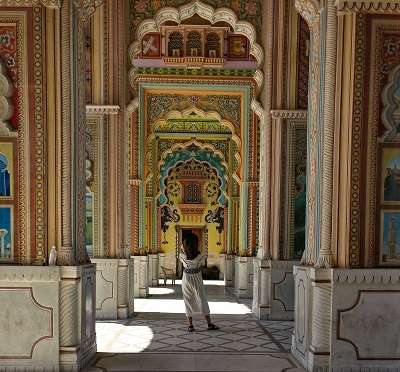
It is the entrance to Jawahar Circle Park. The gate is pink on the outside and when you enter there are various arches and intricately designed structures. It is famous for its rainbow-coloured walkway. Originally there were seven gates for entering Jaipur. This is the 9th and the newest one. It was constructed by Patrika Group in 2016 and inaugurated in 2020 by our PM Narendra Modi. A fountain show is held in the evening at 7 o’clock. It is a perfect spot for photography and getting that perfect Instagram photo clicked. It is really advised to visit early in the morning or else you’ve to wait in a long queue to get your photographs clicked.
- Timings: No exact timings
- Entry fee: Free
10. Chokhi Dhani
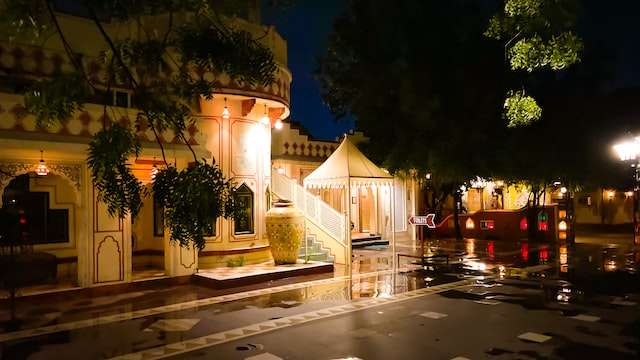
It is a resort created like a village representing the Rajasthani heritage, culture, traditions and food. The village was set up in 1989. There are various cultural performances, folk songs and dances which will give you the rustic feel of Rajasthan. Some of the activities you should not miss when in Chokhi Dhani are the play featuring the Battle of Haldighati, Rath Khana where chariots used by royal families are on display, temples inside Chokhi Dhani, elephant, camel, horse and bullock cart rides, performances of Kalbeliya, Ghoomar and Chari dances, mehendi and henna artists, games such as Bhoomi Bhulaiyya, Jungle Saer, Gufa Jharni etc., shopping and National Museum.
- Timings: 05:00 p.m. to 11:00 p.m. on all days of the week.
- Entry fee: ₹750 to ₹ 1200 for adults and ₹450 to ₹800 for children.
- Pricing depends on the type of food you choose.
- Entry is free for children below the age of 3.
Some more places to visit in Jaipur:-
11. Birla Mandir
12. Hathni Kund Trail
13. Sisodia Rani ka Bagh
14. Raj Mandir Cinema
15. Gaiter ki Chattriyan
16. Man Sagar Lake
17. Galta Ji Temple
18. Lakshmi Mishtan Bhandar
19. Moti Dungri Ganesh Ji Temple
20. Bapu Bazaar
21. Albert Hall Museum
FAQ’S =》
Q1. How to reach Jaipur?
Ans. Jaipur is well connected by air, rail and roads. Jaipur has an international airport which has regular flights to most countries. Trains are available from all parts of India and cost between ₹100 – ₹2000 depending on where you live. If you’re travelling by bus then Jaipur has a major bus stand where lots of tourists come. It is the Sindhi Camp bus stand.
Q2. Where to stay?
Ans. Hotels, hostels, homestays and resorts are all available based on your budget. If you are on a tight budget then try to stay at hotels near the bus stand or railway station. Hostels are a great option for students and youngsters. If you want to experience the royal Rajasthani culture then stay at resorts near the palaces.
Q3. How many days should we plan for the trip?
Ans. 3 days and 2 nights is an ideal duration to explore the city. It generally depends on how you want to explore and which places you want to skip or add to your itinerary.
Q4. What is the best time to visit Jaipur?
Ans. November to March is the ideal time to visit Jaipur as the weather is pleasant during winter. It gets too hot during the summer.
Q5. How to travel in Jaipur?
Ans. E-rickshaw, cycle rickshaws and auto rickshaws are ideal options to explore the city. You can also hire an ola, uber or a cab. However, if you have a tight schedule or have many places to visit in a single day then I will recommend you rent a scooter or bike.
Q6. What to eat in Jaipur?
Ans. Jaipur boasts of its unique and authentic cuisines. Local restaurants and family-run businesses are a thing in Jaipur. Some famous dishes to try here are Pyaaz ki Kachori, Gatte ki Sabzi, Lassi, Kadhi, Bajra Roti, Khichdi, Dal Bati Churma and Lal Maans.
07. Where to book tickets to visit the monuments in Jaipur?
Ans. You can book your tickets on both online and offline platforms. You can also try buying the “Composite ticket” which covers 7 destinations including Hawa Mahal, Jantar Mantar, Amer fort, Nahargarh fort, Albert Hall, Sisodia Rani Ka Bagh and Vidyadhar Garden.
Q8. For how long is the Composite ticket valid?
Ans. The ticket is valid for up to 2 days. In case the monument is closed for one day then it will be valid on the next working day. Entry is free for children up to the age of 7.
Q9. How much does the Composite Ticket cost?
Ans. For Indian tourists the ticket costs ₹100 and for students ₹40. For foreign tourists the ticket costs ₹400 and for students it costs ₹200.
Q10. What are some useful tips while travelling in Jaipur?
Ans.
1. Always carry your sunscreens as it is mostly sunny all year round.
2. Always check the authenticity of the websites if you’re booking online tickets.
3. Always be careful about your belongings as there have been some incidents of pickpocketing.
4. Dress according to the weather and the society as the locals of Jaipur are conservative. You can always dress up in traditional clothes as they will add to the charm of your royal experience.
5. Be humble and respectful towards the locals and society.
6. Do not roam around the city uselessly until late at night and especially if you’re alone.
7. Do not write, scratch or do anything to tarnish the places.
8. Be mindful of accidents especially if you’re visiting places with water or palaces on hilltops.
9. Be careful about choosing your company. While travelling solo remembers to make authentic friends and not fall for any kind of traps.
10. This is the most cliche one but also the most important. Always remember to carry medicines and other first aid items.
Go, check out the city and use our tips and other information available and let us know in the comments about your experience in Pink City.

